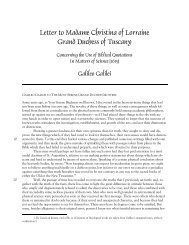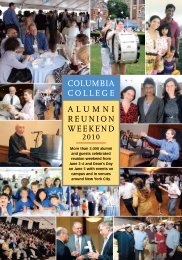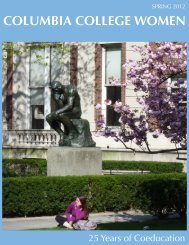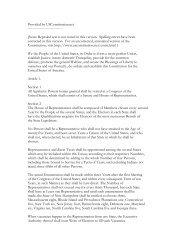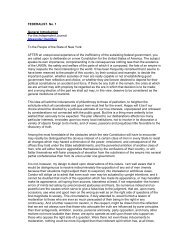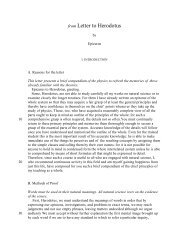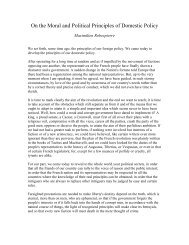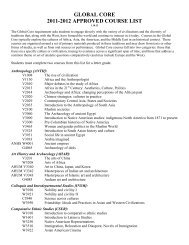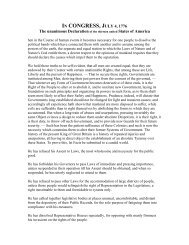Download this issue as a PDF - Columbia College - Columbia ...
Download this issue as a PDF - Columbia College - Columbia ...
Download this issue as a PDF - Columbia College - Columbia ...
You also want an ePaper? Increase the reach of your titles
YUMPU automatically turns print PDFs into web optimized ePapers that Google loves.
DR. GEORGE YANCOPOULOS ’80<br />
COLUMBIA COLLEGE TODAY<br />
COLUMBIA COLLEGE TODAY DR. GEORGE YANCOPOULOS ’80<br />
Regeneron is New York’s largest biotech company, with<br />
the biopharmaceutical industry.<br />
The company lived up to Crain’s billing with revenues of<br />
nearly $1.4 billion in 2012, tripling its totals for 2011. Driving the<br />
explosive growth is the drug EYLEA, used to treat age-related<br />
macular degeneration, the leading cause of vision loss in people<br />
aged 50 and older.<br />
This dise<strong>as</strong>e is caused by abnormal growth of blood vessels<br />
behind the retina, in the back of the eye. The blood vessels become<br />
weak and prone to leakage, which damages the retina.<br />
EYLEA’s active ingredient — a genetically engineered molecule<br />
— binds to a protein that encourages blood vessels, and does so<br />
in a way that inhibits blood-vessel proliferation.<br />
The drug won approval from the FDA in November 2011, after<br />
more than a decade of research and clinical trials. In January 2012,<br />
the company forec<strong>as</strong>t EYLEA sales of $125–$150 million that year.<br />
By year’s end, EYLEA had become so popular among ophthalmologists<br />
that sales reached $838 million.<br />
Plans to market the drug in Latin<br />
America, Japan and Europe are under<br />
way.<br />
“It’s now one of the top five blockbusters<br />
in biotech history,” says Yancopoulos.<br />
“We’re so well positioned right<br />
now. In the l<strong>as</strong>t few years, we’ve gone<br />
from a company that w<strong>as</strong> struggling to<br />
one that’s profitable. It’s a very exciting<br />
time for us.”<br />
At Regeneron’s Westchester<br />
campus, Yancopoulos greets<br />
a visitor wearing jeans with a<br />
white button down over a<br />
gray T-shirt, and three pens in his shirt’s<br />
bre<strong>as</strong>t pocket. He lives in Yorktown,<br />
N.Y., with his children, Damis George<br />
(17), Luka (15) and Demetra (12). His<br />
other daughter, Ourania (19), attends W<strong>as</strong>hington University in St.<br />
Louis.<br />
As Regeneron’s chief scientific officer, Yancopoulos oversees<br />
the company’s robust research program, which h<strong>as</strong> deep <strong>Columbia</strong><br />
roots. The company research efforts focus on two platforms:<br />
the technology that creates new approaches to doing research,<br />
and the research itself, with Yancopoulos helping to find new<br />
targets, developing molecules for those targets, creating clinical<br />
opportunities and then bringing a drug through the federal approval<br />
process.<br />
Yancopoulos meets regularly with the scientists to plan and<br />
strategize about their projects while also making sure that promising<br />
candidates move through a rigorous scientific process.<br />
Drew Murphy ’87 GSAS, s.v.p., Regeneron Research Laboratories,<br />
w<strong>as</strong> a teaching <strong>as</strong>sistant in Yancopoulos’ cl<strong>as</strong>s in molecular<br />
biology at <strong>Columbia</strong>.<br />
“George is all science, all the time,” says Murphy, who joined<br />
the company in 1999. “He tends to look at things differently. The<br />
researchers will have meeting after meeting and come up with<br />
a consensus view of how to proceed. Then George will pull out<br />
something from a different point of view. He’s always right.”<br />
Yancopoulos also will go to great lengths to make sure his<br />
findings stand up.<br />
Yancopoulos, who in March received a 2013 John Jay<br />
Award for distinguished professional achievement, is<br />
described by a colleague <strong>as</strong> “all science, all the time.”<br />
PHOTO: EILEEN BARROSO<br />
“He’s highly skeptical of his data and doesn’t believe his own<br />
results until he h<strong>as</strong> gotten them in multiple ways, using multiple<br />
methods,” says David Gl<strong>as</strong>s ’81, who w<strong>as</strong> Regeneron’s v.p., muscle<br />
dise<strong>as</strong>es, from 1991–2005 and now teaches at Harvard Medical<br />
School and conducts research in Cambridge, M<strong>as</strong>s. “He’s one<br />
of the strongest scientists I’ve ever worked with.”<br />
The success of EYLEA is the latest triumph for Yancopoulos<br />
in a brilliant science career that w<strong>as</strong> nurtured at Bronx Science<br />
in the mid-1970s, when he conducted a research project on a<br />
single-celled organism, Blepharisma. He w<strong>as</strong> named a finalist in<br />
the 1976 Westinghouse Science Talent Search competition, which<br />
solidified his dream of becoming a scientist.<br />
As a <strong>Columbia</strong> freshman, Yancopoulos took a position working<br />
in the laboratory of Professor Jonathan Greer ’81J, who used X-ray<br />
crystallography to study how proteins worked. It w<strong>as</strong> f<strong>as</strong>cinating<br />
yet painstaking research, and Yancopoulos eventually grew restless<br />
with the pace of progress.<br />
By his senior year, Yancopoulos<br />
decided to move on. He’d become enthralled<br />
by new technologies that allowed<br />
scientists to clone genes, so he<br />
dropped crystallography to dive into<br />
that n<strong>as</strong>cent field.<br />
Yancopoulos lived on campus but<br />
typically made it home to join his<br />
mother and father for Sunday dinner in<br />
Middle Village, Queens. He captained<br />
the <strong>Columbia</strong> crew team his senior<br />
year and kept in shape by running to<br />
Queens on some Sundays — an eightmile<br />
jog through Central Park and over<br />
the 59th Street Bridge.<br />
His one regret: not accepting an invitation<br />
to row with the national lightweight<br />
team in 1980.<br />
“I went to medical school instead,”<br />
he says. “I always wonder how I would have done on the team.”<br />
Drug discoverers like Yancopoulos have to learn to be patient.<br />
It took Regeneron two decades to earn its first drug<br />
approval, in 2008, and it can cost more than $1 billion to<br />
take a drug from concept to market. In 2012, the company<br />
had three drugs on the market, 12 drugs advancing through<br />
clinical trials and more than a dozen under development that are<br />
candidates for tests on humans. The drugs under development<br />
cover the gamut of human maladies: cancer, eye dise<strong>as</strong>es, pain, inflammation,<br />
bone dise<strong>as</strong>e, muscle disorders, metabolic dise<strong>as</strong>e and<br />
obesity, infectious dise<strong>as</strong>e and cardiov<strong>as</strong>cular dise<strong>as</strong>e.<br />
“It never ce<strong>as</strong>es to be an adventure,” says Yancopoulos. “My<br />
theme h<strong>as</strong> always been that you need to be willing to risk failure.<br />
Scientific research is a business of failure, and you have to keep<br />
learning from it.”<br />
One such failure came in 1997, five years into development of a<br />
drug for the treatment of amyotrophic lateral sclerosis, known <strong>as</strong><br />
Lou Gehrig’s dise<strong>as</strong>e. Results were unfavorable from the Ph<strong>as</strong>e 3<br />
clinical trial, in which large numbers of people were tested to confirm<br />
the drug’s effectiveness, monitor side effects and compare it<br />
to commonly used treatments. The drug w<strong>as</strong> never brought to<br />
market.<br />
2,000 employees and 2012 revenues of nearly $1.4 billion.<br />
“We were a little arrogant and naïve,” he says.<br />
A seemingly promising drug to treat obesity met a similar fate<br />
in 2003.<br />
Regeneron, however, hadn’t wagered its entire pot of investment<br />
capital on just one or two drugs. There always were several<br />
more in the pipeline.<br />
“When we had the failure, we already had new things we<br />
were working on,” says Yancopoulos. “It’s best to keep investing<br />
in the next great thing. You can’t wait for a drug to fail. You’ve got<br />
to create a new bet.”<br />
Having top leadership helped, too. As Regeneron suffered<br />
through a bout of start-up pains in the mid-1990s, Schleifer heard<br />
that Vagelos, the pharmaceutical executive whom Yancopoulos’<br />
father suggested should be his son’s role model, had reached the<br />
mandatory retirement age at Merck. Schleifer wondered if Regeneron<br />
might woo him to chair the company’s board of directors.<br />
Yancopoulos doubted he’d come on<br />
board. “My dad had been telling me<br />
for 20 years to call Roy Vagelos,” says<br />
Yancopoulos. “I told Len: ‘What, are<br />
you crazy Roy Vagelos isn’t going to<br />
return your phone call.’”<br />
But Schleifer called Vagelos, and<br />
Vagelos did return his call. It turned<br />
out that Vagelos, one of the University’s<br />
most generous benefactors, had<br />
read scientific papers Yancopoulos had<br />
published during Regeneron’s early<br />
years. The man who led Merck to the<br />
pinnacle of the international pharmaceutical<br />
industry w<strong>as</strong> now interested<br />
in the Westchester start-up whose first<br />
drug approval w<strong>as</strong> still 13 years away.<br />
“George had demonstrated leadership<br />
in cloning important genes that<br />
might have an impact on dise<strong>as</strong>e, and<br />
it w<strong>as</strong> clear that he would eventually<br />
score by making an important drug,” says Vagelos. “I w<strong>as</strong> willing<br />
to make a bet on that.”<br />
Vagelos, who h<strong>as</strong> been chairman of Regeneron’s Board of<br />
Directors since 1995, joined the company just <strong>as</strong> Yancopoulos’<br />
team w<strong>as</strong> developing the scientific tools to transition Regeneron<br />
from a company focused on neurobiology, creating drugs to<br />
treat neurological dise<strong>as</strong>es, to one that used mouse genetics and<br />
mouse technology to develop therapeutics for a broad range of<br />
dise<strong>as</strong>es.<br />
Tom DeChiara ’90 GSAS, Regeneron’s senior director of transgenic<br />
technology until 2011, arrived in Tarrytown in 1992. He had<br />
begun to explore embryonic stem cell technology and Yancopoulos<br />
saw its promise.<br />
DeChiara learned quickly of Yancopoulos’ leadership talent<br />
and scientific acumen. For example, DeChiara says, Yancopoulos<br />
is methodical and contemplative at meetings <strong>as</strong> he listens to what<br />
everyone h<strong>as</strong> to say, and then offers his interpretation of the data.<br />
He can be a t<strong>as</strong>km<strong>as</strong>ter <strong>as</strong> well.<br />
“He holds your feet to the fire, but not in a demeaning, negative<br />
way,” DeChiara says. “He does it in a way that makes you realize<br />
that you’ve erred. He says you were wrong, but won’t make<br />
you feel like a moron.”<br />
Dr. Leonard Schleifer, president and CEO of Regeneron<br />
(left); Yancopoulos; and Dr. P. Roy Vagelos ’54 P&S,<br />
chairman of Regeneron’s Board of Directors, at the<br />
2013 John Jay Awards Dinner in March that honored<br />
Yancopoulos and four other alumni.<br />
PHOTO: EILEEN BARROSO<br />
DeChiara w<strong>as</strong> part of the Yancopoulos research team<br />
that found a way to better understand the genetic code<br />
of human beings by manipulating the genes of the<br />
laboratory mouse, a close mammalian cousin whose<br />
genes are remarkably similar to humans.<br />
When scientists mapped the human genome, they were able<br />
to identify the 25,000 genes that compose the human genetic<br />
code. While the genes were identified, the function of many of<br />
these genes w<strong>as</strong> still unknown.<br />
Yancopoulos’ team engaged in what is known <strong>as</strong> the “knock<br />
out” process, in which a gene is made inoperable and scientists<br />
observe how its absence changes a mouse’s functioning. Knowing<br />
what a gene does is a first step toward developing drugs to<br />
either incre<strong>as</strong>e or decre<strong>as</strong>e its function.<br />
While there are other “knock out” technologies, Yancopoulos’<br />
laboratory h<strong>as</strong> developed a group of technologies — subsequently<br />
adopted by the National Institutes of<br />
Health — to determine the function of<br />
thousands of unknown genes. The Regeneron<br />
method does gene knock outs<br />
rapidly, and at scale, rather than one or<br />
a few at a time.<br />
The VelocImmune mouse — which<br />
Regeneron calls the largest mammalian<br />
genetic engineering project ever<br />
accomplished — h<strong>as</strong> substituted the<br />
genes from the human immune system<br />
into mice, which then have the capability<br />
of producing human antibodies<br />
that can serve <strong>as</strong> potent therapeutics.<br />
“Until you have a tool, you can’t<br />
imagine what you can build with it,”<br />
Yancopoulos says. “At one point, I w<strong>as</strong><br />
<strong>as</strong>ked, ‘Why are you spending a couple<br />
of million dollars on it It’s just a drain<br />
on the company.’ But I said, ‘Let’s let<br />
the guys figure it out,’ and they did.”<br />
Yancopoulos’ scientific rigor h<strong>as</strong> paid dividends on Wall Street<br />
<strong>as</strong> well <strong>as</strong> in medical clinics, <strong>as</strong> Regeneron developed into what’s<br />
called a FIBCO — fully integrated biotech pharmaceutical company,<br />
which takes a drug from discovery to manufacturing and<br />
marketing. Regeneron h<strong>as</strong> funded its research through partnerships<br />
with major pharmaceutical companies around the world.<br />
“When Roy came in, our stock w<strong>as</strong> $2 a share,” Yancopoulos<br />
said in March. “Two years ago it w<strong>as</strong> $18. Since EYLEA won approval<br />
from the FDA, the stock price h<strong>as</strong> risen to $172. Our market<br />
capitalization is now valued at $16 billion.”<br />
Yancopoulos’ father p<strong>as</strong>sed away in 2010, before EYLEA hit<br />
the market and became a biotech sensation. Would he be proud<br />
of his son today<br />
“My dad w<strong>as</strong> an old-time guy, a WWII veteran, a tough sort<br />
of guy who rarely expressed anything so positive,” Yancopoulos<br />
recalls. “Even in 2010, I still w<strong>as</strong>n’t good enough; he w<strong>as</strong> still <strong>as</strong>king<br />
me if I w<strong>as</strong> pushing myself. But at the funeral, a bunch of his<br />
cronies told me what I knew deep down inside: He w<strong>as</strong> always<br />
bragging about me to them.”<br />
David McKay Wilson, a columnist at The Journal News in White<br />
Plains, N.Y., also writes regularly for TC Today at Teachers <strong>College</strong>.<br />
SUMMER 2013<br />
34<br />
SUMMER 2013<br />
35




